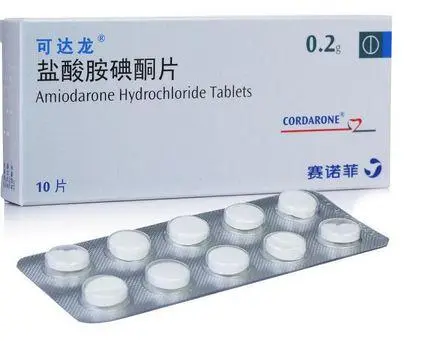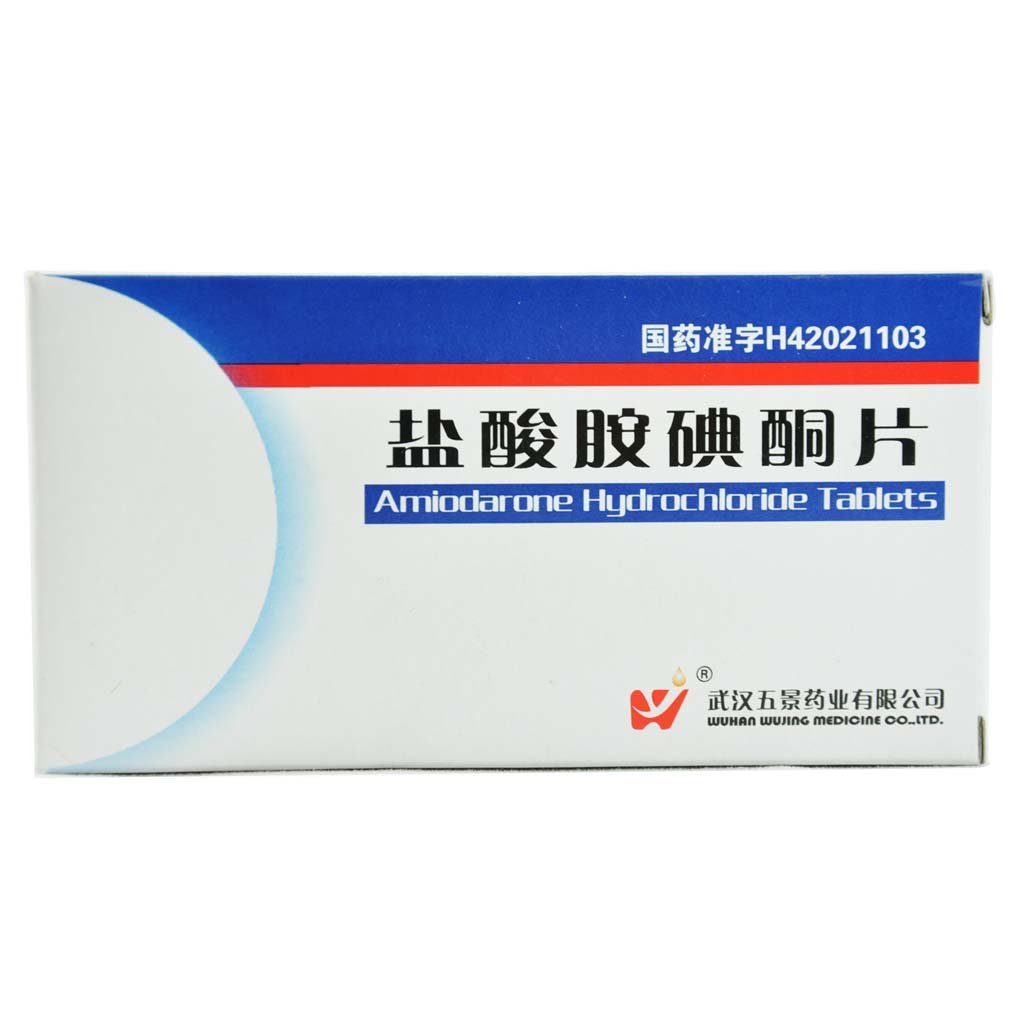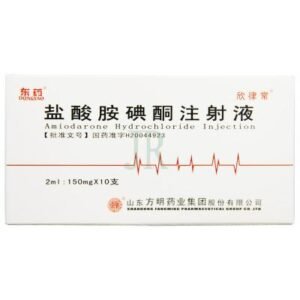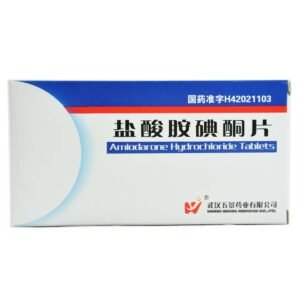Amiodarone
Function:
Oral preparation is used for the following cardiac arrhythmias: atrial arrhythmias (atrial flutter, atrial fibrillation, maintenance of sinus rhythm after cardioversion and cardioversion). Nodal arrhythmias. Ventricular arrhythmias (treatment of life-threatening premature ventricular contractions, ventricular tachycardia, prevention of ventricular tachycardia, ventricular fibrillation). Arrhythmias with preexcitation syndrome (WPW syndrome). Injections are used for severe arrhythmias that are not suitable for oral administration, especially for atrial arrhythmias accompanied by rapid ventricular rhythm. Tachycardia in WPW syndrome. Severe ventricular arrhythmias. Cardiopulmonary resuscitation for ventricular fibrillation-associated cardiac arrest in which external defibrillation is ineffective.
Dosage:
Oral loading dose for arrhythmia: 600 mg per day, which can be used continuously for 8-10 days. Maintenance dose: The minimum effective dose should be used. Depending on individual response, 100-400 mg a day can be given. Since the therapeutic effect of amiodarone lasts longer, 200 mg every other day or 100 mg a day can be given. Intermittent treatment with two days off medication per week has been recommended. The initial dose of intravenous injection is 300 mg (or 5 mg/kg) in 20 ml 5% glucose solution and injected rapidly. If ventricular fibrillation persists, additional 150 mg (or 2.5 mg/kg) via intravenous route should be considered. No other drugs should be added to the syringe. The dose of intravenous infusion in the first 24 hours can be individualized according to the patient, but the initial infusion rate should not exceed 30 mg/min. Usually 1000 mg of this drug is given within the first 24 hours, and can be administered in the following ways: ①Loading infusion: 150 mg in 100 ml 5% glucose solution in the first 10 minutes (drip rate is 15 mg/min, infusion solution concentration is 1.5 mg/ml), followed by 360 mg administered 6 hours later (drip rate 1 mg/min, infusion concentration 1.8 mg/ml). ② Maintenance infusion: administer 540 mg in the remaining 18 hours (drip rate is 0.5 mg/min, infusion concentration is 1.8 mg/ml). 720mg is administered every 24 hours after the first 24 hours (drip rate is 0.5mg/min, infusion concentration is 1~6mg/ml, infusion concentration exceeding 2mg/ml requires central venous catheter administration), can be used in conjunction 2-3 weeks. If ventricular fibrillation or hemodynamically unstable ventricular tachycardia occurs, an additional dose of 150 mg in 100 ml of 5% glucose solution (the infusion concentration is 1.5 mg/ml) can be administered and continued to be infused for 10 minutes. The maintenance infusion rate may be increased to suppress arrhythmias. For supraventricular arrhythmias, take orally, 400~600mg a day, divided into 2~3 times. After 1~2 weeks, the dosage can be changed to 200~400mg daily as needed for maintenance. Some patients can reduce to 200mg, 5 days a week or Maintenance at a lower dose. Oral administration for severe ventricular arrhythmias, 600~1200mg per day, divided into 3 times, gradually change to 200~400mg per day for maintenance after 1~2 weeks as needed. Amiodarone injection is prepared with only 5% glucose solution. Do not add any other preparations to the infusion set. Instill via central venous line whenever possible. When the concentration of the infusion solution exceeds 3 mg/ml, the occurrence of peripheral phlebitis will increase. If the concentration is below 2.5 mg/ml, the above-mentioned situations will be less likely to occur. If an intravenous infusion is required for more than 1 hour, the amiodarone concentration should not exceed 2 mg/ml unless a central venous catheter is used. The response to amiodarone varies widely between individuals, so although a loading dose is necessary to suppress life-threatening arrhythmias, close monitoring and dose adjustment as needed are essential. When using PVC materials or equipment, amiodarone solution can release diethyl phthalate (DEHP) into the solution. In order to reduce the patient’s exposure to DEHP, it is recommended to use PVC or glassware that does not contain DEHP and temporarily prepare and prepare it before use. Dilute amiodarone infusion solution.
Adverse reactions:
Common adverse reactions (incidence ≥1%) of this product include: cardiac abnormalities: generally moderate, dose-dependent bradycardia, congestive heart failure. Endocrine abnormalities: thyroid abnormalities, hypothyroidism and hyperthyroidism. Gastrointestinal abnormalities: benign intestinal dysfunction (nausea, vomiting, anorexia and constipation), abdominal pain, abnormal taste. Injection Site Reactions: Possible inflammatory reaction, superficial phlebitis, injection site reaction when administered via direct peripheral intravenous route. Vascular abnormalities: facial flushing, moderate and one-time drops in blood pressure. Ocular abnormalities: Corneal microdeposits, usually limited to the subpupillary area. Skin abnormalities: photoallergic reaction, lavender or blue-gray pigmentation on the skin. Pulmonary abnormalities: Diffuse interstitial or alveolar lung disease and bronchiolitis obliterans with organizing pneumonia (BOOP). Nervous system abnormalities: malaise, weakness, tremor, involuntary movements, lack of coordination, gait abnormalities/ataxia or other extrapyramidal symptoms, sleep disturbance, headache, nightmares, decreased libido, sensory, motor or mixed peripheral neuropathy. Liver abnormalities: isolated elevated serum aminotransferases, acute liver function abnormalities, presence of high serum aminotransferases and/or jaundice. Blood and Lymphatic System Abnormalities: Coagulation Abnormalities.
Drug contraindications:
Contraindicated during pregnancy and lactation if allergic to this product
Share:
Products
Our offers
Health Classification
Let us work together to protect precious health


































